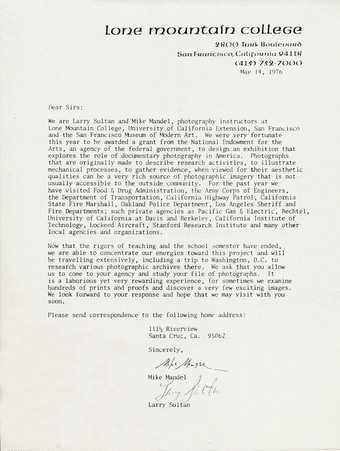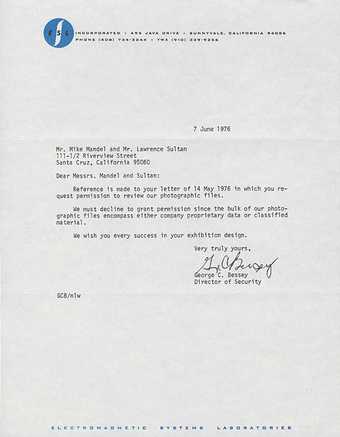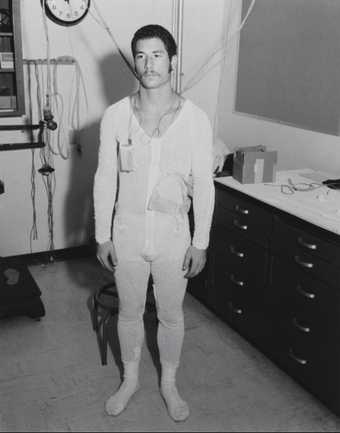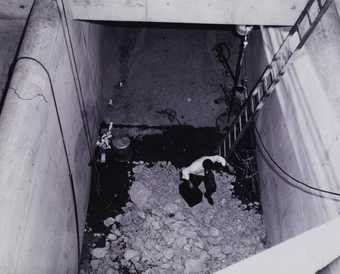
Fig.1
Larry Sultan and Mike Mandel
Clatworthy Colorvues logo, c.1975
Larry Sultan and Mike Mandel met in 1974 as MFA candidates at the San Francisco Art Institute. During their time there the two artists formalised their activity by producing work under the banner of a mock corporation, Clatworthy Colorvues.1 The company’s name was poached from a twentieth-century American vernacular postcard manufacturer, and the duo designed an accompanying logo featuring a coat of arms (fig.1): the lower half shows the collision of two atoms, while at the top left a pair of hands holds a bunch of oranges that are on fire and on the right is a diagram of Brownian motion – the random movement of microscopic particles in a fluid as a result of their collision with fast-moving atoms or molecules. The coat of arms is surrounded by a circle whose outline is made up of many smaller circles, with the word ‘Clatworthy’ inscribed at the top and ‘Colorvues’ at the bottom, both in capital letters.
The Center for Creative Photography at the University of Arizona holds the archives of Sultan and Mandel’s Clatworthy Colorvues. This includes the letters sent between Clatworthy Colorvues and the participating corporations for the photobook Evidence and for the exhibition held at the San Francisco Museum of Art in 1977. The exhibition featured eighty-nine found photographs collected from the archives of seventy-seven aerospace weapons and energy organisations and research institutions, most of which were located on the California coast. These were then reduced to fifty-nine and published without captions in Sultan and Mandel’s photobook the same year (Tate P14478–P14510 and P20292–P20294).

Fig.2
Letter from Larry Sultan and Mike Mandel to ESL Incorporated, 14 May 1976

Fig.3
Reply from ESL Incorporated to Larry Sultan and Mike Mandel, 7 June 1976
In the correspondence, in which Sultan and Mandel requested access to the various organisations’ files, a handful of institutions expressed hesitancy over the classified content of their activities (see their letters to and from the ominously named corporation Electromagnetic Systems Laboratories (ESL) Incorporated, figs.2 and 3). Lockheed and Bechtel were two of the many corporations that Sultan and Mandel contacted that were at the forefront of defence-orientated research in America, and in most cases these same institutions were also developing new weaponry for the American military during the wars in Korea (1950–3) and Vietnam (1955–75). In order to gain access to these ‘top secret’ institutions, which also included NASA and RAND, Sultan and Mandel wrote to them using the letterhead of Clatworthy Colorvues and enclosed a document giving details of their government grant from the National Endowment for the Arts (NEA) and a letter from the San Francisco Museum of Art’s photography curator, John Humphrey. The NEA grant acted as a free pass to enter and exit at will, since the corporations believed that they were participating in a government project and they naturally wanted to be represented.2 As Mandel reflected:
We loved the fact that we could get into all these places that built missiles and weapons and major engineering projects and get to look at all the imagery that was hidden away. These were the centers, the aerospace-energy-weapons corporations: Bechtel, TRW, JPL, Aeronutronic Ford, Lockheed, Northrop, United Technologies, Berkeley Radiation Labs who were in many senses creating the world.3
In the case of ESL, the artists were denied permission to view their archive on the grounds that the bulk of the photographic files featured proprietary information. Furthermore, the photographs at many of the institutions were labelled in their respective archives ‘classified’ or ‘declassified’. Sultan and Mandel were permitted to see the ‘declassified’ documents, and these were often older, taken in the 1950s or 1960s, whereas the ‘classified’ photographs depicted present and recent activities – those from the 1970s. The corporations had to keep their photographs classified in this way because many of their projects were tied to government contracts.4
Past, present and future
Speaking on the subject of ‘classified’ and ‘declassified’ material, Sultan described Evidence as a troubling of the coordinates of past, present and future.5 This weaving together of different temporalities provided, in Sultan’s words, ‘clues to the future’:
We continued to visit archives at police and fire departments and government regulatory agencies, but more importantly, we were facing the kind of images that intuitively were resonating with us as the engineering corporations that were building the weapons, space vehicles, the technology of the future. Ironically, the documentation of these projects was made with a photographic technology from the past. The older, more formal 4 x 5s were made in black and white, illuminated by flash, possessed an archaic, deliberate, crafted quality. The language of the past was giving us clues to the future.6
Many of the corporations Sultan and Mandel visited were the same corporations said to be ‘building the future’ of America, or, in the words of Mandel, ‘creating the world’. Positioned squarely at the height of cold war, during an era of anxiety surrounding push-button nuclear warfare, the Evidence photobook and exhibition marked time in a complicated sense. The photographs, taken in the 1950s and 1960s, indexed the relatively recent past, and yet, since these corporations were said to be ‘building the future’ of America, each image also implicated the present moment as a past-future. The photographs of experiments that make up Evidence were staged by their original photographers to anticipate the future; furthermore, it could be argued that Sultan and Mandel’s work excavates a lost future that is latent in each image.

Fig.4
Larry Sultan and Mike Mandel
Untitled 1977, printed 2001, from Evidence 1977
Tate P14484
Although the photographs Sultan and Mandel collected were documents originally produced to illustrate, record and explain each corporation or institute’s activities in the present, their chosen imagery was of a strange and otherworldly nature. An example of this is the photograph of a man in a white undergarment, wires strapped to his body, connected to machine outside of the frame – or perhaps the clock in the background (fig.4). The wires resemble intravenous tubes, but instead of delivering blood or medicine, they seem to send ‘time’ into the man’s body. ‘As a whole,’ Mandel has stated, ‘[Evidence] suggests a mysterious atmosphere of an unexplained, technologically driven, dehumanizing future.’7 The photographs ‘looked a little bit like science fiction’, Sultan also mentioned in an interview in 2003, ‘although [they were] very much about science fact’.8 The confusion between the photograph operating as scientific fact and then functioning as science fiction echoes a similar observation made by writer Susan Sontag in her influential book On Photography (1973). ‘At one end of the spectrum,’ Sontag writes, ‘photographs are objective data; at the other end, they are items of psychological science fiction.’9
‘The facts are crazy sometimes,’ Sultan has stated. ‘They are really kind of loopy, almost like science fiction, a world gone slightly mad, so that duet between an official document and a world depicted that is out of control – that’s what we were interested in.’10 Sultan and Mandel’s Evidence confused the terrains of fact and fiction to produce an eccentrically strange, future-orientated image.11 Once again, interpretation appears drawn to the work’s comic figures and scenarios – figures and scenarios that appear close to the eccentric characters of American slapstick, encountered in films such as Charlie Chaplin’s Modern Times (1936), that diagnose the machines and structures of scientific rationality as irrational and dysfunctional.
This perspective on the estranging characters of science fiction closely aligns with critic Darko Suvin’s Brechtian definition of science fiction as a literary genre based on the presence and interaction of ‘estrangement and cognition’, whose primary formal device is the construction of an imaginative framework alternative to the author’s and reader’s environment.12 In his foundational essay entitled ‘Progress versus Utopia; Or, Can We Imagine the Future?’ (1982), the critic and political theorist Fredric Jameson makes a similar argument about science fiction, suggesting that the genre does not provide the reader with images of the future, but rather operates to defamiliarise and restructure our experience of our own present.13 The imagined futures of science fiction transform the present ‘into the determinate past of something yet to come’ – a present, Jameson notes, not accessible to contemplation due to the sheer volume of objects, individuals and experiences that characterise our contemporary situation.14 In Jameson’s framework, science fiction allows its reader to view the present as history.
Sultan and Mandel have described their method as a type of ‘guerrilla opportunity’ against corporate cold war America – a chance to use the images made by these organisations against them in an act of subversion, especially in the context of the late 1970s, when the Vietnam War had just come to an end.15 Mandel remarked in 1977 that the early 1970s was a time that involved a reassessment of basic values. The Vietnam War had catalysed a revolution of consciousness in which many citizens rejected both the war and corporate America. ‘No we’re not going to go kill ourselves in [Southeast] Asia’, Mandel wrote in 1977, ‘and we don’t need your jobs in corporate management.’16 Sultan and Mandel used their own ‘facts’ of the corporation, to cite the words of Mandel, ‘to create an opposing narrative from where the pictures were from’.17 One should not read this ‘opposing narrative’ as an escape from reality, but as something subversive.
Sultan and Mandel’s Evidence produces a temporal model that reflects not only on how the past works on the present, but also how the present thinks through the past. Their temporal model is both historical and non-historical at the same time: it is historical in that they work with image fragments culled from the just-past, yet the final product is non-historical insofar as their work introduces a new narrative sequence closer to the realm of dystopian science fiction that troubles the coherent unfolding of history, as well as, more fundamentally, the relationship between past, present and future.18
Science fiction, science fact
When viewed within the regional context of California, Sultan and Mandel’s recourse to the genre of science fiction is far from coincidental. For many historians and literary critics of the region, the state of California reads as pure science fiction. Carey McWilliams, an early historian of the area, claimed in 1949 that California was positioned ‘at the edge of novelty’.19 This is the same California described by science fiction writer Ursula K. Le Guin as ‘bright, dry, clear, strong, firm, active, aggressive, lineal, progressive, creative, expanding, advancing, and hot’.20 California attained this reputation through innovation in science and technology, and through entrepreneurial acumen.21 In the post-war period – the very period that Sultan and Mandel focus on in Evidence – the region became a machine for the cold war, enhanced as it was by defence spending, population growth and defence-related suburban development. Historian and urban theorist Mike Davis has aptly called it a ‘vast empire of cold war science’.22
The list of innovations tied to the region is as impressive as it is long: aviation in the 1880s; vacuum tube technology for radio and television in the 1920s; the splitting of the atom in the 1930s; the development of the semi-conductor in the 1950s; the creation of the personal computer in the 1970s; and, more recently, the development of biotechnology.23 This constant innovation means that California has no particular past in which it can ground itself – ‘no past, at least, that it is willing to remember’, to cite the words of writer Rebecca Solnit. This is what makes the region so dexterous in manufacturing the future, Solnit writes, whether in the fields of science and technology or in the dream factory of a Hollywood film set.24
Each technological and scientific development was not only linked to innovation, historian Kevin Starr writes, but also to a strong profit motive. It is through science and technology, suggests Starr, that California both imagined and invented itself as an American place.25 Central to California’s project was the construction of quasi-autonomous public-private institutions like the Stanford Research Institute – one of the many that Sultan and Mandel visited – which served the defence industry as much as Stanford University as a whole. As Starr details at great length, the post-war period saw the rise of the cold war campus that appeared to be a ‘classified place’ devoted to defence-related research and supported by federal funds.26 These public-private institutions not only took over and transformed traditional universities, such as Stanford and the University of California, Berkeley, but also developed their own private bodies, the so-called ‘think-tanks’ epitomised by the RAND Corporation, the Hughes Aircraft Company and NASA’s Jet Propulsion Laboratory – all corporations involved in Sultan and Mandel’s Evidence project.27 ‘Open, flexible, entrepreneurial, unembarrassed by the profit motive,’ Starr argues, ‘California emerges as a society friendly to the search for utopia through science and technology.’28 When one encounters the violent and destructive images published in Evidence, the sentence could easily be rewritten by switching the words ‘utopia’ with ‘dystopia’: ‘California emerges as a society friendly to the search for dystopia through science and technology’. The section of this In Focus entitled ‘California in Catastrophe’ explores further the dystopic tone and tenor of Evidence.29
LA detective fiction: Truth and paranoia
Alongside the genre of science fiction, another possible interpretation of Sultan and Mandel’s Evidence could lie in the work’s links to the genre of detective fiction. Literary historian David Fine has remarked that Los Angeles detective stories are often precisely about ‘excavating the past’, a mode of thinking that attempts to recover memory and a repressed history. The best example here is Raymond Chandler’s The Big Sleep (1939): before the novel begins, a murder has taken place ‘off the page’, so to speak, but the key evidence – the body – remains hidden throughout the novel among the oil fields owned by the wealthy Sternwood family. The just-past is therefore presented as both the site and the source of the crime, and the oil fields serve as a literal landscape of evidence. ‘The Los Angeles mystery plot’, writes historian of the genre Paul Skenazy, ‘maintains a double rhythm: moving inexorably forward in time while creeping slowly backward to resolve the disruptions and violence evident in the present.’30 The private detective is employed as an archaeologist of sorts, hired to bring the crime to the surface: to proceed from what philosopher Ernst Bloch has referred to as a ‘pre-narrative, un-narrated state’ to a narrated state.31 Yet in Evidence there is no privileged all-seeing eye such as that embodied by the character of Chandler’s Philip Marlowe, who wields the power of observation and logic to assert a definitive judgment. Here, such acts of deduction are left open to the reader.32
A decade before Sultan and Mandel arranged their photographs to make Evidence, writer Thomas Pynchon drafted his own take on the LA detective novel in the form of The Crying of Lot 49 (first published in 1966). Pynchon’s novel charts the circuitous movements of Oedipa Mass (the inverse of Sophocles’s Oedipus Rex), who is the executor of the will of her former lover, the billionaire developer and industrialist Pierce Inverarity. Both The Crying of Lot 49 and Evidence satirise the detective novel as well as scientific and technological culture in California – their relationship to evidence (criminal, detective, photographic, scientific) being one of the means of doing so. In Pynchon’s novel, Inverarity has transformed Los Angeles (called San Narcisco by Pynchon) into a technological leviathan that sucks Mass into its orbit. Like most of the men featured in Evidence, Mass’s former lover desires to ‘alter the land, to bring new skylines, personal antagonisms, growth rates into being’.33
The Crying of Lot 49 navigates the productive, if not comical, tension between paranoia and conspiratorial truth. The work adopts a paranoid literary style insofar as Mass’s discoveries read as one vast delusion consisting of an intricately woven tapestry of signs and referents, and conspiratorial truth lies in the fact that these signs do, in fact, allude to a world illuminated in its patterns and connections. Pynchon defined paranoia in his later epic Gravity’s Rainbow (1973) as the ‘reflex of seeking other orders behind the visible’.34 One can classify Pynchon’s writing as a type of paranoiac imaginary, which follows on from psychoanalyst Jacques Lacan’s early definition of the paranoiac as ‘a coherent structure of immediate noumenal apprehension of oneself and the world’.35 According to Lacan, when faced with a confusing set of experiences the paranoid subject creates an ‘original syntax’ to make sense of this objective yet seemingly delusional reality.36 The paranoid subject does not develop from an individual delusion, but rather is constructed as a response to alienating and atomising social conditions. As a consequence, paranoia and conspiratorial truth assume an objective form.
In The Crying of Lot 49, as in Sultan and Mandel’s Evidence, historical fact and fiction intermix in a dizzying comedy, always forcing the protagonist, and the reader, to second-guess themselves. With each turn of the novel’s pages, more ‘clues’ are seemingly found – similar in a sense to Sultan and Mandel’s project, with its images paired on facing pages – and yet with every page turn each successive revelation also creates a larger and larger enigma that loops back onto itself and ultimately spirals out of control.37 Although Pynchon’s main character acts like a detective throughout the novel, accumulating more evidence to add to the pile, the story is beset by references to magic, the supernatural and conspiratorial madness that aids in explaining the plot’s disorientating manoeuvres. Analogous in its form, Sultan and Mandel’s Evidence is premised on a similar set of moves in which rationality is consistently marked by irrationality, order by disorder, structure by chaos. In this particular photographic formulation, reality appears to continually collapse into unreality. Only by crafting an ‘original syntax’ that mixes paranoia with conspiratorial truth do these experiences begin to add up.
As mentioned above, Sultan claimed that although the photographs sequenced in Evidence were sourced from archives of scientific fact, the photographs themselves looked more like science fiction. Just as the detective novel served as a literary trope for the historic avant-garde in the 1920s and 1930s, artists adopted science fiction in the 1960s and 1970s as an analogous artistic model for the neo-avant-garde.38 The elaborate connection between the genre of science fiction and the depiction of the world ‘out of control’ as represented in Evidence affirms Susan Sontag’s observation that science fiction films are not about science per se, but about disaster.39 In her essay ‘The Imagination of Disaster’ (1965), Sontag argued that this imagery of disaster is crafted from a variety of sources: the fantasy of viewing one’s own death, the fantasy that imagines the destruction of cities and, finally, the fantasy of imagining the complete annihilation of humanity itself.40 Sontag’s observations, penned in the 1960s, were informed by the period’s imminent threat of nuclear war, and she viewed the genre in a negative light. Science fiction films, Sontag writes, are escapist: ‘[they] normalize what is psychologically unbearable, thereby inuring us to it’.41

Fig.5
Larry Sultan and Mike Mandel
Untitled 1977, printed 2006, from Evidence 1977
Tate P20293
Putting aside Sontag’s negative diagnosis, what is more compelling about science fiction and its relationship to Sultan and Mandel’s project is the genre’s own connection to the logic and structure of detective fiction. Social and literary theorist Marc Angenot has argued that the reader, when confronted with the imaginary world of science fiction, must move as if he or she were passing through ruins and fragments; building on Angenot’s point, literary theorist and critic Tom Moylan has argued that the reader transits through the text like a detective uncovering clues to make sense of this newfound world.42 As in the classic detective and science fiction texts set in and around LA, with Evidence the reader is asked to absorb information, uncover patterns and try to act decisively within a dystopian environment, in the process making a conjectural reconstruction of this fictitious world.43 There are countless subjects figured in Evidence, for instance, who appear as if they were confronting, for the first time, some inexplicable event or environment (fig.5). The reader of science fiction, similar to the reader of detective fiction, must manoeuvre within what Jameson calls ‘strategies of indirection’ – a type of reading that proceeds through scraps and fragments, which approaches its object only at an angle, indirectly.44
